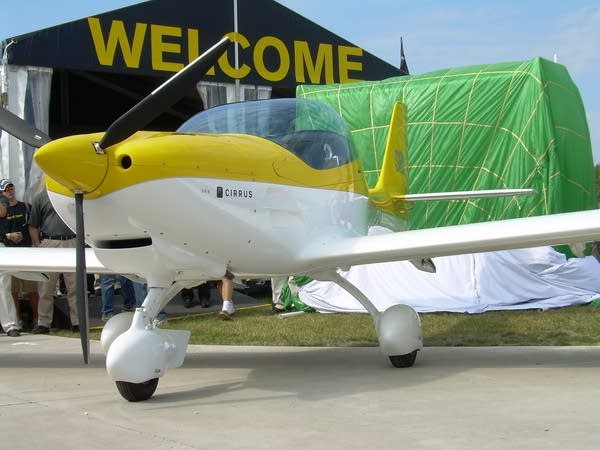High-flying Cirrus tries to slow down

A few weeks ago, Cirrus Design unveiled plans to build and market a light jet, seeking to capitalize on a growing industry to sell individual jets to pilots who don't mind spending $1 million to travel fast, and in luxury.
But at a news conference at AirVenture in Oshkosh, the country's largest general aviation convention, the company did an about-face in its approach to aviation, entering the so-called "light sport aircraft" market, an emerging market made possible by new FAA rules which allow people to learn to fly at a much lower cost, and with much less training, in airplanes that are less expensive and slower.

The company announced a partnership with Fk Lightplanes of Germany to build a new airplane -- called the SRS -- at a factory in Krasnow, Poland, with final assembly at the company's production facilities in the Upper Midwest.
The new LSA -- light sport aircraft -- category of pilot and airplane certification is aimed at resuscitating an ailing general aviation industry in the United States. Flying is expensive to learn, and airplanes are expensive to buy or rent, a fact that threatens Cirrus and every other manufacturer of general aircraft.
Create a More Connected Minnesota
MPR News is your trusted resource for the news you need. With your support, MPR News brings accessible, courageous journalism and authentic conversation to everyone - free of paywalls and barriers. Your gift makes a difference.
"When Alan and I were kids," said Cirrus co-founder Dale Klapmeier, "we'd ride our bicycles to the airport to see what planes were there. Now, there are no kids at the airport. We want to bring kids back to the airport."
It won't be easy.

Few can learn to fly on an average person's salary. It can cost upwards of $5,000 and more than 50 hours of instruction time to learn to fly, more than $100 an hour to rent an airplane, and anywhere from $200,000 to a half-million dollars to buy smaller planes, such as Cirrus SR-20 and SR-22.
According to Tom Poberezny, the president of the Experimental Aircraft Association, which sponsors the convention, there are 600,000 pilots in the United States, 25 percent fewer than a few decades ago.
World War II-trained pilots provided the spark to the aviation industry in the country. "But they're leaving us now and we've never had an infrastructure to replace them," he said.
Under the "light sport" category, training time is cut in half (as few as 15 hours of instruction will be required), and a slower, cheaper, lighter airplane can be purchased for around $80,000.
Cirrus co-founder Alan Klapmeier refused to say how much his new airplane will cost.

Several Cirrus competitors, most notably Cessna, have already begun production of the smaller and slower models, an acknowledgement that unless a substantial number of new pilots emerge in the next few years, the general aviation (non-commercial) industry is doomed.
"We think it's great that Cessna got into the LSA market," Klapmeier said, denying that the company's surprise announcement was motivated by its main competitor. "It's essential that the industry support the light-sport aircraft market."
But rather than design and build the new airplane, the company will partner with the German firm to build it, based on a model currently flying in Europe called the Fk14 Polaris.
The move presents a new challenge to the Duluth-based company that specializes in fast -- and expensive -- planes: building one that won't fly fast.
As presently constructed, the Fk14 flies too fast to meet the new FAA rules. Planes eligible to be flown by the "new" pilots can fly no faster than 120 knots, have room for only one passenger, and cannot fly at night.
Klapmeier expects few problems in redesigning the model, and says it should be available for purchase within a year.
Still unclear is whether the company's additional direction in the aviation market will lead to significant job growth at the company's Duluth headquarters.
Because the plane will be built in Poland, only final assembly will be performed by Cirrus.
One other Minnesota firm stands to benefit by Monday's announcement, however. Ballistic Recovery Systems of South St. Paul supplies parachutes to Cirrus, which are installed in all of the company's airplanes as an emergency device. The new airplane will also use the firm's product, Cirrus officials said.
